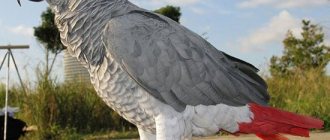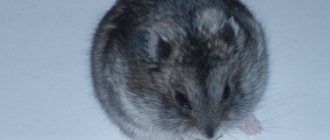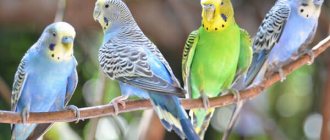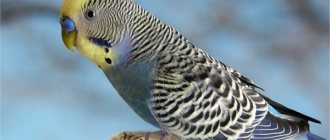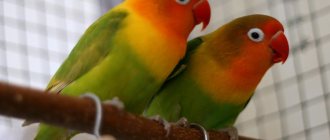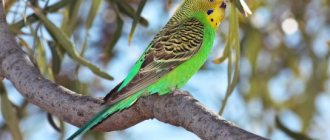Color, appearance
A distinctive feature of these pets is their bright, variegated coloring with a predominance of green, but there are also monochromatic types of parrots. Many species have long crests and tails. The eyes of birds are relatively large and protected by the lower eyelid.
Their beak is also special - large, bent, sharp. The parrot's thick and short legs have four fingers with claws, two of which are turned back, which allows the bird to bring food to its beak. Some species of these birds can reach up to 1 meter in length, and the smallest are only 10 cm.
Where is the best place to buy
Having decided on the type of parrot to keep at home, you should choose the place of purchase. You can buy a feathered pet in several places:
- by hand according to an advertisement;
- in a pet store, at a poultry market;
- in a nursery or from a reputable breeder.
We recommend reading: How to name your parrot
All options have advantages and disadvantages. When purchased second hand, the bird will be inexpensive, but its health may be poor. In a pet store or at a bird market there is less risk of buying an unhealthy parrot, but there is no question of raising a pet. The best (albeit the most expensive) option would be to buy from a nursery or from a professional breeder. In this case, the parrots will have good health, the necessary vaccinations and documents. Both nurseries and breeders are involved in raising birds, they know the character traits of each pet and can select a suitable individual.
Parrots make wonderful pets. Before purchasing, you should carefully study the information about each species and prepare the habitat. It is necessary to understand that this is a living creature with its own needs and characteristics, and even within a species the characters of different individuals differ.
Share the article on social networks and leave comments.
Types of parrots
At home, it is recommended to breed both small species of parrots - budgies, lovebirds, as well as medium-sized ones - cockatiels and large ones - grays, macaws, cockatoos, Amazons.
Budgerigar
The budgerigar is the most famous species of pet parrot. You can keep one parrot, two different-sex parrots, or several birds at once in a cage. The natural color of budgies is grassy green. Through domestication, the color of parrots characteristically diversified into bright and light colors.
The color of the cere tells about the sexual characteristics of the pet. In the older male it looks bright blue, in the young one – purple; in a mature female it is brown, in a young female it is blue.
The beak of this parrot is strong, dark in color in chicks, and pale yellow with a green tint in mature birds. These birds belong to the talking parrots and do not make unnecessary noise.
Keeping budgies does not pose any difficulties. You just need to do the following every day:
- monitor the food in the feeders;
- change water;
- clean the cage;
- let fly;
- provide fruits, vegetables, herbs;
- Give him a bath once a week;
- love your pet.
Rare species of parrots! Pearl 05.12.13, 17:06
There are more than 350 species of parrots in the world, and about a third of them are now under threat of complete destruction... This number is constantly increasing, for which there are many reasons.On average, parrots live a long time and therefore have a relatively low reproductive rate. Some of the larger species raise only one chick at two or three years before leaving the nest. In such species, the population grows slowly even without natural disasters or the influence of predators.
Breeding parrots and their eggs are excellent prey for many predators. Because they nest in tree hollows, they are easy prey for many climbing or flying predators. As humans settled, they introduced predatory animals both intentionally and accidentally.
All over the world, deforestation is occurring at an incredible rate. The result is a decrease in the number of nesting sites. Many, many years must pass before the tree grows large enough and rots from the inside, forming a hollow that can accommodate a pair of macaws with chicks. Smaller parrots use palm trees. But even fast-growing palms need at least 20 years to grow to the desired size.
Many species of insects such as bees and wasps compete with parrots for cavities.
In underdeveloped countries, where the population is large, local residents use almost all living things for food. Parrots are shot or caught and eaten. The lack of money encourages local residents to catch and sell parrots for literally pennies.
Over the long years of the existence of the mass trade in parrots, of the many individuals captured, only a few survived.
Stress itself kills. A bird under stress loses its immunity and is exposed to pathological infections. Therefore, many captured birds die when they end up in new homes.
Parrot hunters try to catch chicks - fledglings. They are taken from the nest at the most appropriate age - not too young so that they do not feed so often, but not adults either - so that they can fly away.
Many species are catastrophically disappearing from the face of the Earth. But trapping is cheaper than breeding.
Who knows what species of parrots will be listed next as rare and endangered? At the beginning of the twentieth century, the Carolina parrot was so
amazed that its huge flocks covered the sky. Today it is completely destroyed.
In this issue we begin to introduce you to endangered parrot species.
Blue-bellied malachite parrot (lat. Triclaria malachitacea).
If these charming parrots were less rare, they would be in great demand among hobbyists. Besides being beautiful, they have a very melodious voice. Having a length of about 30 cm, they weigh only 142 g. Males have a purple color on their belly, which determines their gender. Other than this, the birds are completely green, with an amazing white beak. This species is rarely kept in captivity and has only been bred by a small number of hobbyists. Native to southern Brazil, these birds live in sparse forests and are sweary and secretive. These parrots tend to protect their territory, so they often nest at a distance of up to 2 km from each other.
Vulture parrot (Gypopsitta vulturina).
The extraordinary vulture is one of two species of parrots that have almost no feathers on their heads, rather than just bare cheeks like a macaw. Such bald patches indicate that food is quite soiling the plumage and the birds may be eating very ripe fruits. This species, mysterious to ornithologists, has not been studied in the wild and is unknown for breeding. Those who tried to keep this species, unfortunately, were not able to keep it alive for long. Perhaps, with the help of the knowledge accumulated by breeders today, these attempts will be more successful.
Yellow-eared parrot (Ognorhynchus icterotis).
The extremely rare yellow-eared parrot is a species very similar to the macaw. It is distinguished by a rectangular patch of bare skin running from the beak to the throat. The Andean bird is only now becoming the subject of study, and it may be too late to save it from extinction. According to our information, only one pair of birds was kept in captivity, which unfortunately did not reproduce.
complain
Characteristics and features of parrots
A characteristic feature of parrots is their bright colors, long crests and tails. The movable strong beak of a parrot serves not only for eating, but also for defense and movement along tree branches. The singing of parrots has individual characteristics and also depends on the character and mood of the pet.
By nature, parrots are quite friendly, sometimes they show themselves in a very funny and funny way, surprising others. These birds require proper care and treatment; they cannot tolerate loneliness and begin to show whims. Pet parrots can be noisy and create chaos in their cage.
Corella Parrot Habitat
These cute birds are found almost throughout Australia, with the exception of very dry areas and the eastern part of the mainland, where rainforests are located. It is also impossible to meet these birds close to the shore. In appearance, these birds are somewhat similar to cockatoos, but cockatiels have a longer tail and look more elegant. Just like cockatoos, these birds have a crest, the feathers of which fall and rise depending on the mood of the bird.
The cockatiel is a bird of the cockatoo family and the only species of its genus.
An interesting feature: cockatiels do not have a layer in their plumage that is responsible for structural coloring, so the color of the feathers is determined solely by pigments. Caring for these birds is much easier than for larger members of the family. Corellas can be kept not only in enclosures, but also at home.
Parrot nutrition
It is necessary to provide pet parrots with a complete and varied diet. Various grain mixtures make up 60% of your pet's food. Parrot food depends on the size of the parrot and living conditions in nature; brands such as Padovan, Versele-Laga, Fiory, RIO are recommended.
It is also advisable to give raw and boiled fruits, vegetables, berries, fresh herbs, sprouted wheat and oats, branches of fruit trees, various cereals and mineral supplements.
Be sure to have fresh water in the cage. Several times a month you can give a drink with lemon juice (1-2 drops), a decoction of chamomile or rosehip. The parrot's menu can be adjusted taking into account the bird's age, condition, and season.
Brown cockatiels
This species gets its name due to its color – these birds’ main color is not gray, but brown. This mutation appeared in 1950 in New Zealand. These cockatiels were bred in artificial conditions - in enclosures, but there is information that among the representatives of the wild form living in Australia, birds with brown plumage were seen.
Several color variations of cockatiels have been bred - pure white, pearl, variegated and others.
Like lutino cockatiels, color in cinnamon cockatiels is directly related to gender. As they grow up, males acquire a darker color compared to females.
Maintenance and care
Keeping parrots at home does not involve any particular difficulty. The very first purchase for a pet should be a spacious cage - all-metal and simple, rectangular in shape, 5 times the size of the bird, with a good lock.
The cage must be placed in a bright, wind-free room, and it is advisable to cover it with a blanket at night. Maintaining silence will allow the bird to feel comfortable.
The parrot's cage is equipped with the necessary items and toys - rings, swings, bells, perches - for activity, mirrors - for the desire to talk. Daily cleaning is part of caring for your pet. This includes washing the tray, feeder and drinking bowl, and replacing the bedding.
The parrot must be let out of the cage to fly. Communication is an important part of caring for your pet. When a bird gets bored, it begins to pluck out its feathers and becomes sad, for this reason it is necessary to devote half an hour to it twice a day.
For the reproduction of parrots and the appearance of chicks, it is necessary:
- choose the right pair of parrots;
- age of individuals from 12 months;
- the presence of a nest or house - each pair has its own nest;
- proper fortified diet;
- temperature 22 degrees, humidity 60%.
Egg laying and incubation period is approximately 1-2 months.
Advantages and disadvantages
Buying a parrot requires an objective assessment. You should soberly assess the situation and weigh the pros and cons before bringing a tropical bird into your home. It is worth emphasizing that large parrots require more space, so it is best to place them in aviaries . Let's look at the advantages and disadvantages of keeping feathered pets.
pros
- Large parrots become very attached to their owners and become their best friend.
- Communication skills. Tropical birds can easily learn to imitate speech.
- Most species have a very contrasting plumage color, which cannot but please the eye.
- Large parrots are easy to train. If you give them a little time, they will learn not only to talk, but also to perform various tricks.
- In comfortable conditions and with proper care, such parrots can live for decades.
- These feathered pets are distinguished by their cleanliness. You won't have to constantly clean because of the bird's actions.
- There is practically no need to walk a tropical bird.
Minuses
- Buying a large parrot can be very expensive.
- Some species are considered quite rare on the domestic market, and they can be very difficult to acquire.
- In case of illness, it is very difficult to find specialists to treat a parrot, and the price for an appointment is exorbitant.
- Due to its size, a parrot requires a sufficient amount of space, the minimum is an aviary, the maximum is a separate room. It is also recommended to install perches around the perimeter for birds to sit.
- Loud noise. Large parrots are quite loud in their speech, so those who like silence are not recommended to have such birds in their home.
- Parrots are very active birds, so the possibility of them damaging furniture or clothing cannot be ruled out.
- Changeable mood. In a state of aggression, birds can cause various injuries to their owner.
- Large parrots require a lot of attention. If there is a lack of communication, they may become depressed. In some cases, it can lead to self-plucking. The consequences of this can be tragic.
There are not many varieties of large parrots that can survive at home. Each of them has a unique character and requires an individual approach.
Among large birds, the macaw is considered the largest species of parrot. The natural habitat of the tropical bird is central and southern America. It is quite rare in the form of a pet due to its size (from 50 to 100 centimeters).
It is very difficult to keep such birds indoors because of their loud voice and powerful beak, which can ruin many things in the house. These birds are considered quite intelligent, but teaching them to speak requires a lot of time and effort.
For keeping in the house, it is best to purchase the following types of macaw parrot.
- Red . The length of the body can reach 85 centimeters. It got its name due to its bright red plumage.
- Blue-yellow. Body length can vary from 80 to 86 centimeters. The parrot itself is colorful. The abdominal part of the body is yellow, and the back and wings are blue. The feathers located on the frontal part are colored green.
- Hyacinth . It can reach one meter in length, the plumage has a rich purple color with blue tints.
Cockatoo
The natural habitat of this breed of parrots is Australia and Oceania. The length of the body can reach 50 centimeters, and body weight – up to a kilogram. It has a powerful beak and a bright crest. Cockatoos live in flocks, so at home they will be very attached to all members of the household.
These artistic birds love to be given a lot of attention and will never make their owners bored. Parrots are also very sociable and easy to train.
Due to an unstable nervous system, they are prone to sudden mood swings.
Varieties.
- Mourning . The price for such a bird is very high, and the species itself is rare. Color – black. Males and females are characterized by the presence of a red stripe on the tail. Females differ in that they have yellow spots on their black plumage.
- Black . These large parrots can weigh up to one kilogram and have a body length of 80 centimeters. The plumage is green and black. It is not recommended to keep it at home.
- Yellow-crested . Easy to train. Learns spoken language quickly. The length of the body can reach 50 centimeters. Average weight is 1 kilogram.
Unlike other colored parrots, these birds have a modest white color. The crest is colored yellow.
Amazon
Unlike previous varieties, the size of these birds is much smaller (30-40 centimeters). Amazons have green plumage. In the wild, these large parrots live on the South American continent. The lifespan of birds is long and can reach 70 years. A parrot can easily be taught to speak. Amazons are restless and inquisitive birds. A parrot of this breed will become the best friend for its owner.
The most popular types.
- Yellowhead . Body length can reach about 40 centimeters. The parrot's plumage is green. The top of the head has a yellow tint.
- Blue-faced . The case size can reach 45 centimeters. The plumage of parrots is also green. The feathers on the head have a bluish tint. Blue-faced birds are an endangered species.
Chinese ringed
This type of parrot is quite large in size. The length of the body can reach 50 centimeters, most of which falls on the tail. The bird weighs about 350 grams. The plumage on the head of the Chinese parrot is blue. It smoothly transitions to the abdominal part of the body. The plumage on the wings and back is green. Its head is characterized by the presence of black stripes. The beak can be used to determine the sex of parrots. In males, the upper part of the beak is red, while in females it is painted black. Birds are highly intelligent and require constant attention.
The natural habitat of the Chinese parrot is China and India.
Cockatiel nutrition
Typically, these birds consume one and a half tablespoons of feed per day. Breeders must ensure that the birds do not overeat, this is detrimental to their health. The maximum permissible daily food intake is two tablespoons. You should give your cockatiels fruits and vegetables to meet their needs for minerals, vitamins and trace elements.
Cockatiels are skilled at begging for pieces of food and opening locks while no one is looking.
